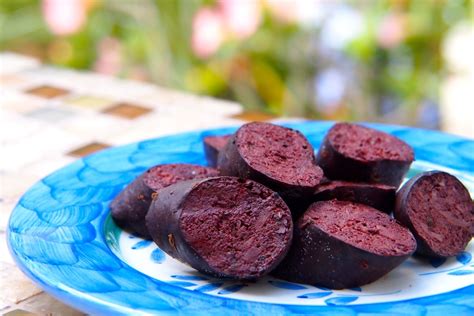Recipe: Blood Pudding - A Savory Culinary Tradition
Blood pudding, also known as black pudding, is a traditional savory dish enjoyed across many cultures. While the name might sound a bit intimidating, this recipe will guide you through creating a delicious and surprisingly versatile blood pudding that's sure to impress. This detailed guide covers everything from ingredient selection to cooking techniques, ensuring a successful and flavorful outcome.
Understanding the Ingredients: The Key to a Great Blood Pudding
The key to a truly fantastic blood pudding lies in the quality of your ingredients. Here's a breakdown of what you'll need and why:
- Blood: Traditionally, pig's blood is used, but you can find pre-prepared blood mixes in some butchers or specialty stores. Ensure the blood is fresh and handled hygienically.
- Oats/Barley: These grains provide the pudding's structure and texture. Quick-cooking oats or pearl barley work well.
- Fat: Suet (beef or mutton fat) is traditionally used and contributes to a rich, flavorful pudding. You can substitute with lard or even bacon fat for a different taste profile.
- Onions: Finely chopped onions add a savory base flavor.
- Spices: A blend of spices like sage, thyme, marjoram, and black pepper enhances the overall flavor profile. Experiment with different combinations to find your perfect blend.
- Seasoning: Salt and freshly ground black pepper are essential for seasoning.
Step-by-Step Blood Pudding Recipe
This recipe yields approximately 6 servings.
Ingredients:
- 1 pint fresh pig's blood (or pre-prepared blood mix)
- 1 cup rolled oats (or pearl barley)
- ½ cup suet (or substitute fat)
- 1 large onion, finely chopped
- 1 teaspoon dried sage
- ½ teaspoon dried thyme
- ¼ teaspoon dried marjoram
- ½ teaspoon black pepper
- 1 teaspoon salt
- Sausage casings (natural or synthetic) - optional, but recommended for traditional presentation
Instructions:
- Prepare the Oats/Barley: If using rolled oats, soak them in cold water for at least 30 minutes to soften. If using barley, cook according to package directions until tender. Drain well.
- Sauté the Onions: In a large pan, gently sauté the finely chopped onions in the suet (or substitute fat) until softened and translucent. Avoid browning.
- Combine Ingredients: In a large bowl, combine the cooked oats/barley, sautéed onions, sage, thyme, marjoram, black pepper, and salt. Mix thoroughly.
- Incorporate the Blood: Slowly add the pig's blood to the oat/barley mixture, stirring constantly to prevent lumps.
- Fill the Casings (Optional): If using sausage casings, carefully fill them with the blood pudding mixture using a sausage stuffer or a piping bag. Tie off the ends securely.
- Cook the Blood Pudding: You can cook the blood pudding in several ways:
- Boiling: Gently simmer the pudding in boiling water for approximately 1-1.5 hours, or until firm.
- Baking: Place the pudding in a baking dish, cover, and bake in a preheated oven at 350°F (175°C) for approximately 1 hour, or until firm.
- Pan-frying: If not using casings, shape the mixture into patties and pan-fry until golden brown and heated through.
Serving Suggestions and Variations
Blood pudding is incredibly versatile. Enjoy it as part of a full English breakfast, sliced and grilled, or crumbled into stews and casseroles.
- Breakfast: Serve slices of grilled blood pudding alongside fried eggs, bacon, and toast.
- Savory Dishes: Crumble cooked blood pudding into hearty stews or casseroles for added texture and flavor.
- Snacks: Slice and serve chilled as a snack with mustard or chutney.
Variations:
- Spicy Blood Pudding: Add a pinch of cayenne pepper or chili flakes for a spicy kick.
- Fruity Blood Pudding: Incorporate chopped apples or cranberries for a sweet and savory twist.
- Herb Variations: Experiment with different herbs like rosemary, parsley, or chives.
Tips for Success
- Use fresh, high-quality ingredients for the best flavor.
- Don't overcook the pudding, as it can become dry.
- Let the pudding cool completely before slicing and serving.
This comprehensive guide provides a solid foundation for creating delicious blood pudding. Remember, the key is to experiment and find the combination of flavors and cooking methods that you enjoy most. Enjoy this culinary adventure!

